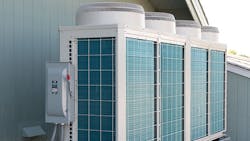What Owners Need to Know About … Duct-Free HVAC
The fastest-growing segment of the U.S. HVAC market, variable-refrigerant-flow (VRF) zoning is a flexible, cost-effective, and environmentally friendly HVAC option for commercial buildings with multiple floors and areas. VRF zoning provides precise comfort control by moving refrigerant through piping to zones in need of cooling or heating. Some VRF zoning systems cool and heat simultaneously, providing personalized comfort to each zone or space regardless of time of day, sun or shade, season, or special requirements. This article discusses seven primary characteristics of VRF zoning technology.
Energy Efficiency
With conventional HVAC systems, central equipment generates sizable capacity, which is delivered via large-volume ducting to an entire floor or building. Fixed-speed compressors in conventional HVAC systems typically operate at full power. In the United States, however, zones exhibit partial-load conditions more than 90 percent of the time. Conventional systems cannot handle partial loads, resulting in energy fluctuations and poor set-point satisfaction.
VRF zoning systems with electric inverter-driven compressors offer full-range variable capacity, delivering only the amount of conditioned air needed for a zone. Working in tandem with integrated controls and sensors, the compressors seamlessly adjust speed to maintain desired capacity. This function, along with ductless design, typically makes VRF zoning systems about 30 percent more energy-efficient than conventional systems, which lose energy through ductwork.
VRF zoning systems can help facilities to meet ENERGY STAR, Green Globes, and LEED (Leadership in Energy & Environmental Design) requirements and achieve the highest integrated-energy-efficiency-ratio (IEER) ratings.
Temperature Control and Energy Monitoring
Load diversity. A VRF zoning system manages different areas of a building based on diversity of load and usage. It adjusts capacity as space loads change and people move about or as the sun moves across the building throughout the day. With load diversity, the total applied capacity of selected air handlers (indoor units) can be up to 150 percent of the capacity of the compressor (outdoor unit).
Intelligent sensor technology. Intelligent indoor-unit sensors measure room air temperature at the return or at a remote controller or wall sensor. Advanced linear electronic expansion-valve technology ensures delivery of the precise amount of refrigerant needed to meet each zone’s load at a given time. Some VRF zoning systems feature sensor technology that compares air and floor temperatures and adjusts coil temperature as needed to optimize comfort within a space.
Intuitive system control. Select VRF zoning systems can cool or heat up to 50 zones. Networked control options allow for the management of a building’s HVAC system down to the indoor-unit level. Capabilities include occupancy sensing, dual temperature set point and setback, mode scheduling, the ability to integrate third-party equipment, storage of maintenance data, and energy-monitoring functions with tenant billing of system energy consumption. Central controllers support interconnection with a networked PC on a local-area network for convenience of monitoring and operation. Other control networks support integration with building management systems for wider system control.
Heat Recovery
Some VRF zoning systems offer highly responsive simultaneous cooling and heating, which maximizes the heat energy absorbed from a space, heat energy that otherwise would be expelled outdoors. The system takes heat energy removed from a zone in cooling mode and applies it to a zone calling for heat. By bypassing the outdoor unit, the system runs in its most efficient state.
Life-Cycle Costs
VRF zoning systems tend to have fewer components than conventional HVAC systems, reducing equipment costs, complexity, and installation time. Also, VRF zoning systems use less refrigerant and have fewer electrical connections. They use built-in logic that modifies behavior to maximize performance, whereas many other systems require retrocommissioning and constant maintenance to preserve installed efficiency. This means greater comfort and longer system life. Many VRF zoning systems require only filter cleaning, an additional cost savings over conventional industry models that call for disposable-filter replacements.
Installation
A VRF zoning system is easily adaptable as the needs of a building change, especially with the rotation of commercial office tenants, who have specific cooling and heating needs. Indoor units can be added and subtracted easily, with minimal interruption of system operation.
Aesthetics
VRF zoning systems help to maintain a building’s interior design with:
- Discreet indoor units: Indoor VRF units are compact and available in multiple styles. Designed to blend into their environments, they can be installed in many different locations. Ductless options include wall-mounted, floor-standing (exposed and concealed), ceiling-recessed cassette, and ceiling-suspended. Ducted options include vertical concealed and ceiling-concealed. Ductless options in particular free up valuable interior space and enable increased ceiling height. Sound levels range from 19 dB(A) at low speed to 49 dB(A) at high speed—quieter than a refrigerator.
- Compact outdoor units: Modular outdoor units are easy to install and can be tailored to almost any building, including being placed on a roof. Many VRF zoning systems are available in air- or water-source variety with a wide range of capacities. Sound levels range from 24 dB(A) to 65 dB(A)—equivalent to an electric shaver.
Ventilation Air
Many VRF-zoning manufacturers offer ventilation products that integrate into the same controls network as indoor units. Dedicated outdoor-air systems (DOAS) can process 100 percent of outdoor air. Energy-recovery ventilators (ERV) can be used in tandem with VRF zoning systems to temper ventilation air. Exhaust air passes incoming ventilation air, providing a heat exchange that allows the incoming air to be heated or cooled to achieve neutral temperatures. Both ERV and DOAS can be monitored via the controls system.
Pamela Androff, PE, LEED AP, is product manager, commercial and product planning, for Mitsubishi Electric US Cooling & Heating Division. In 2013, she became the youngest person and fourth female to serve as president of ASHRAE’s Atlanta chapter, which she also has served as secretary and treasurer. She has a bachelor’s degree in mechanical engineering from the University of Central Florida, where she served as president of the ASME chapter.
Did you find this article useful? Send comments and suggestions to Executive Editor Scott Arnold at [email protected].
